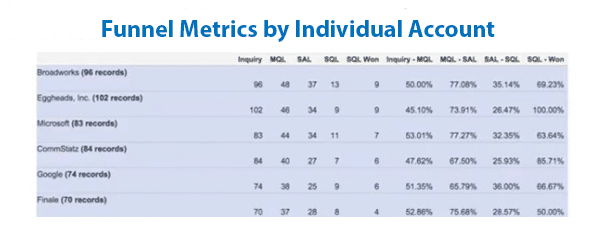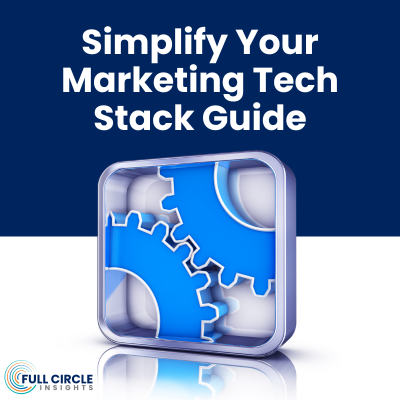
An account based approach to marketing efforts can be extremely valuable—allowing your marketing and sales teams to jointly focus on a set of accounts identified as the best fit for your company. The concept of ABM makes perfect sense and seems pretty straightforward, but executing your ABM strategy can be overwhelming. As you are defining your ABM priorities, how can you prepare your CRM to support these priorities? Here are a few things to consider…
1) Identifying and segmenting your target accounts and key personas
When identifying your target accounts, start with a small list. Work with your sales team to pick their top accounts and identify what makes up their ideal prospects. Key attributes could include firmographic data (location, industry, revenue, company size) as well as other attributes such as installed technologies and product information. If you’re using predictive analytics, you’re already a step ahead and may have identified your Ideal Customer Profile. If you don’t have budget for these advanced technologies, you can still categorize top accounts as targets in your CRM. You’ll also want to ensure that you’ve evenly distributed targets across account owners.
Collaborate with sales to define your persona types—what individuals do they want to sell to and who have they sold to in the past? A Lead’s job title alone may not reveal much about the individual’s role in the organization, and job titles are not standardized enough to use alone. Create fields such as Job Function and Job Level to help segment your audience. Although you are focusing on account-based personas, individual-based personas are still important when identifying decision makers and influencers. This type of segmentation will allow you to build targeted campaigns by channel, with customized messaging and content.
2) Cleaning and organizing your data
It is imperative that your data in your CRM is clean, consistent, and current. To have an effective ABM strategy, you need to have accurate data for your target accounts and for the individuals you build at those accounts. As this can be a difficult undertaking internally, having a partner for data cleansing, enrichment, and de-duping is a must. Luckily many data management platforms can integrate directly into your CRM.
Having a Lead-to-Account matching tool will improve your data and process and is crucial to link Leads to Accounts, convert Leads to Contacts on the right Accounts, and route Leads to the correct salesperson. This solves a huge data gap, saving marketers the headache of matching which Lead belongs to which Account manually and increasing the productivity of your sales team.
Determine who is responsible for your data quality/hygiene. Marketing is adding new names from inbound leads flowing through their marketing automation system. Sales is adding new names with sales tools for their calling campaigns or from one-off interactions. Even if you have a data management provider, whose responsibility it is to check data quality and reconcile differences? Marketing and Sales Ops must work together to own this. Decide together on validation rules for data entry or require key fields to be completed. Create dashboards that display the key data you’re missing or discrepancies that need to be resolved.
3) Tracking engagement and progression through your funnel
Create campaigns in your CRM to track responses across your Leads and Contacts for full funnel visibility. You can segment your campaigns by using custom drop down fields such as channel, offer, product line, region, and you can get more granular on the Campaign Member page layout with mapping funnel stages, persona fields, and account-level data.
Roll-up scoring/rating on the account level based on responses from Leads and Contacts. This will help prioritize marketing inbound leads and sales outbound efforts. What company is this Lead from? Is this company on your target account list? Does the job title fit into one of your personas?
Ensure that you have ways to track progression of both Leads and Contacts at your target accounts. Most organizations use the Lead Status field to track engagement, but are not measuring contact engagement. You need to be able to look at the full marketing and sales funnels and the impact from response to closed deal for both Leads and Contacts.
4) Measuring ABM performance
How do you measure what is working?
Build reports in your CRM that provide insight into account performance based on volume, velocity, and conversion to answer questions such as: How much have we grown the list of individuals within each of our target accounts? How fast are they moving through our funnel stages and where are they getting stuck? How much revenue have we generated from our target accounts? What marketing mix is the most effective based on conversion rates? Below are a few sample reports.
You’ll obviously want to look at your target accounts individually.

You’ll also want to look at your target accounts and see how different campaign types are performing. (This is also a way to compare the performance of your target accounts overall versus your non-target accounts)

These results can be used to validate progress and identify fastest growth in target account segments, while also uncovering what’s been neglected. For example, you may find that you are having traction in a specific industry which was outside your initial set of target industries.
Again, it’s important to start with a small target list to test your strategy and ops process. You may not see the impact initially, but allow yourself time to review what’s working and what’s not, and scale accordingly. You’ll be a few steps closer to achieving a successful ABM strategy. Check out these 6 steps for starting small with ABM.



